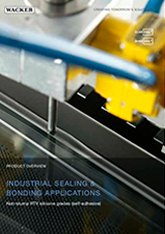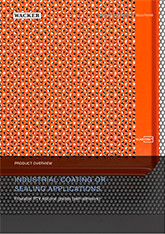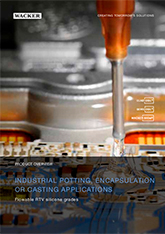Papier & Verpackung

VINNAPAS® Polymerdispersionen werden bei der Formulierung einer breiten Palette an Papier- und Verpackungsklebstoffen verwendet. Sie sind für ihre starke Adhäsion auf einer Vielzahl von Substraten bekannt und zeichnen sich durch eine hervorragende Hitzebeständigkeit und maschinelle Verarbeitbarkeit sowie durch ihre vielseitigen Formulierungseigenschaften aus.
Die WACKER Technical Center bieten Testmöglichkeiten für unterschiedliche Formulierungen von Papier- und Verpackungsklebstoffen. Hier: Prüfung der Abbindegeschwindigkeit.
Product Recommendations
|
Products
|
Technical data
|
Product properties
|
Suitability
|
Papier & Verpackung
|
|||||||||||
|---|---|---|---|---|---|---|---|---|---|---|---|---|---|---|---|
| Solids content | Viscosity, dynamic | Glass transition temperature | Sustainability Aspects |
Papier & Verpackung
|
Papierverpackung & -konvertierung
|
Klebebänder & Etiketten
|
Adhesion
|
Cleanability
|
Nozzle Application
|
Cohesion/ Heat Resistance
|
Roller/ Wheel Application
|
Setting Behavior
|
Water Resistance
|
||
| - - | - - | - - | - | - | - | - | - | - | - | - | - | - | - | ||
| 54,0 - 56,0 % 54,0 - 56,0 % | 1800 - 2700 mPa·s 1800 - 2700 mPa·s | ca. 17 °C[1] ca. 62,6 °F[1] | Low formaldehyde content, Produced without APEO | - | - | - | High | Medium | Excellent | Excellent | High | Medium | |||
| 54,0 - 56,0 % 54,0 - 56,0 % | 1300 - 2300 mPa·s 1300 - 2300 mPa·s | ca. 23 °C[1] ca. 73,4 °F[1] | Produced without APEO | - | - | - | - | High | Medium | Excellent | Excellent | High | High | ||
| 54,0 - 56,0 % 54,0 - 56,0 % | 1800 - 2700 mPa·s 1800 - 2700 mPa·s | ca. 0 °C[1] ca. 32,0 °F[1] | Produced without APEO | - | - | - | Medium | High | Excellent | High | Excellent | High | Medium | ||
| 54,0 - 56,0 % 54,0 - 56,0 % | 3100 - 4400 mPa·s 3100 - 4400 mPa·s | ca. 0 °C[1] ca. 32,0 °F[1] | Produced without APEO | - | - | - | Medium | High | Excellent | High | Excellent | High | Medium | ||
| 54,0 - 56,0 % 54,0 - 56,0 % | 1300 - 2200 mPa·s 1300 - 2200 mPa·s | ca. -15 °C[1] ca. 5,0 °F[1] | - | - | - | - | Medium | High | Excellent | High | Excellent | High | Medium | ||
| 54,0 - 56,0 % 54,0 - 56,0 % | 800 - 2000 mPa·s 800 - 2000 mPa·s | ca. -20 °C[1] ca. -4,0 °F[1] | - | - | - | - | Excellent | Medium | Medium | Medium | Medium | High | High | ||
| 58 - 62 % 58 - 62 % | 4500 - 9500 mPa·s 4500 - 9500 mPa·s | ca. -35 °C[1] ca. -31,0 °F[1] | - | - | Excellent | Medium | Medium | Medium | Medium | Medium | Medium | ||||
| 58 - 61 % 58 - 61 % | 4500 - 9500 mPa·s 4500 - 9500 mPa·s | ca. -35,0 °C[1] ca. -31 °F[1] | - | - | - | - | Excellent | Medium | Medium | Medium | Medium | Medium | Medium | ||
| 51,5 - 52,5 % 51,5 - 52,5 % | 300 - 800 mPa·s 300 - 800 mPa·s | ca. 0 °C[2] ca. 32,0 °F[2] | - | - | - | - | - | - | - | - | - | - | - | ||
| 49 - 51 % 49 - 51 % | 4000 - 6000 mPa·s 4000 - 6000 mPa·s | ca. 3 °C[2] ca. 37,4 °F[2] | - | - | - | - | High | Excellent | Medium | High | Excellent | High | High | ||
| - - | 1700 - 2400 mPa·s 1700 - 2400 mPa·s | ca. 0 °C[1] ca. 32,0 °F[1] | Low formaldehyde content, Produced without APEO | - | - | - | - | - | - | - | - | - | - | ||
| 62,5 - 64,0 % 62,5 - 64,0 % | 200 - 800 mPa·s 200 - 800 mPa·s | ca. 5 °C[2] ca. 41,0 °F[2] | - | - | - | - | High | High | Medium | Medium | Excellent | High | Excellent | ||
| 62,0 - 64,0 % 62,0 - 64,0 % | 600 - 1500 mPa·s 600 - 1500 mPa·s | ca. 0 °C[1] ca. 32,0 °F[1] | - | - | - | - | Excellent | High | Medium | Medium | High | High | Medium | ||
| 69,5 - 71,5 % 69,5 - 71,5 % | 1200 - 2700 mPa·s 1200 - 2700 mPa·s | ca. -3 °C[1] ca. 26,6 °F[1] | Low formaldehyde content, Produced without APEO | - | - | - | High | High | Medium | High | High | Excellent | Excellent | ||
[1] Glass transition temperature | DSC, specific method, [2] Glass transition temperature | specific method, [] Suited, [] Well suited, [] Ideally suited













